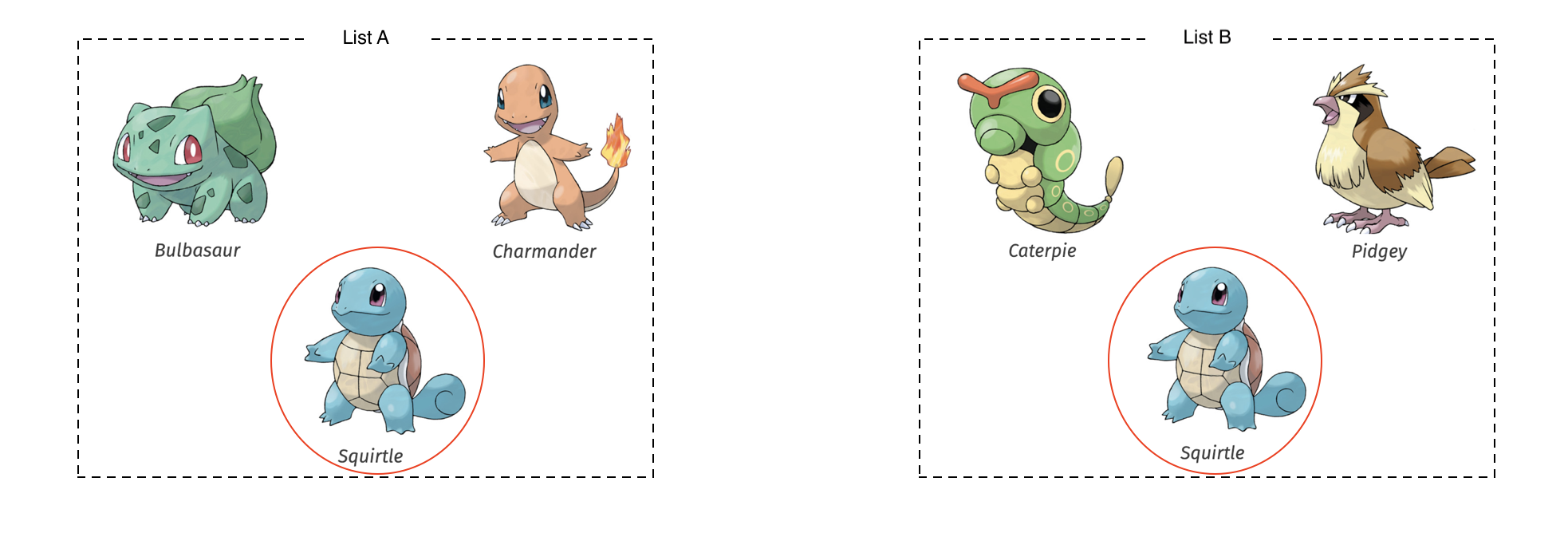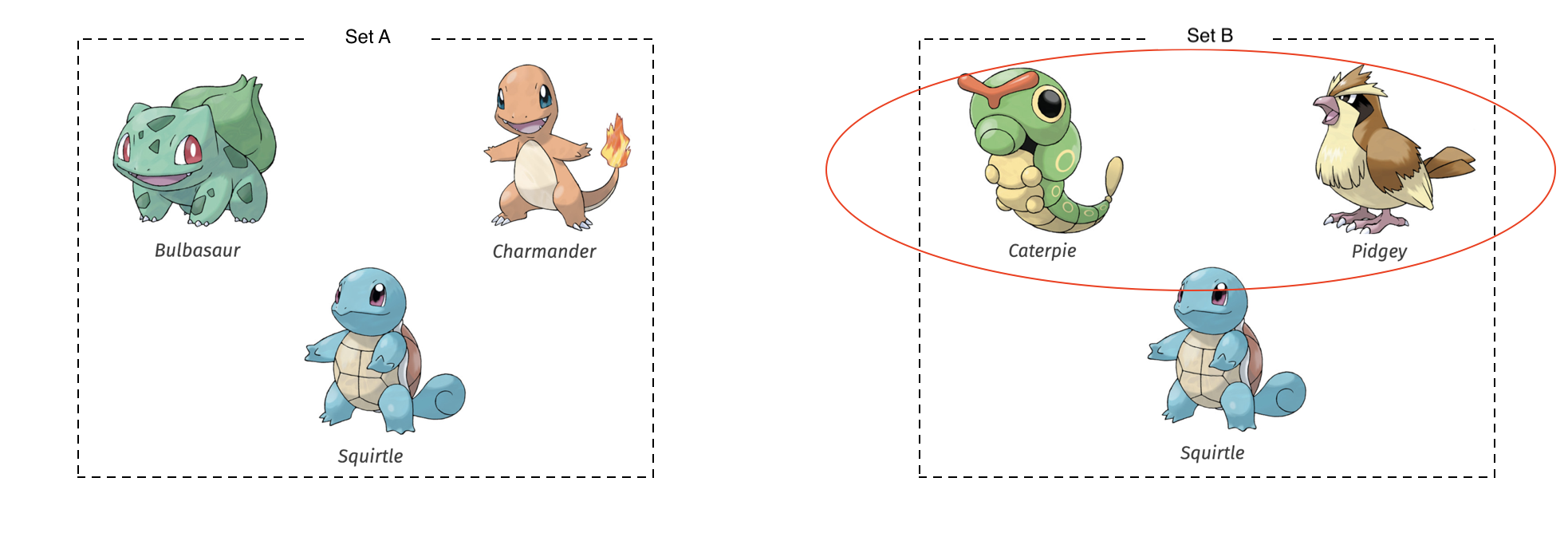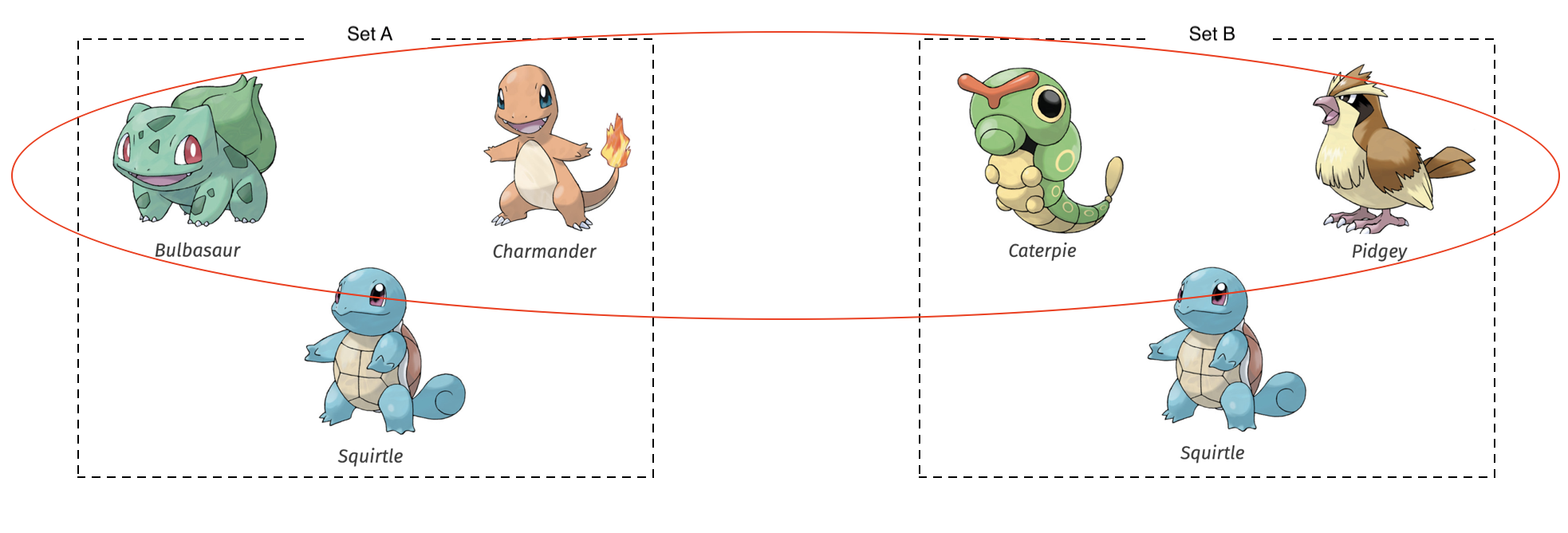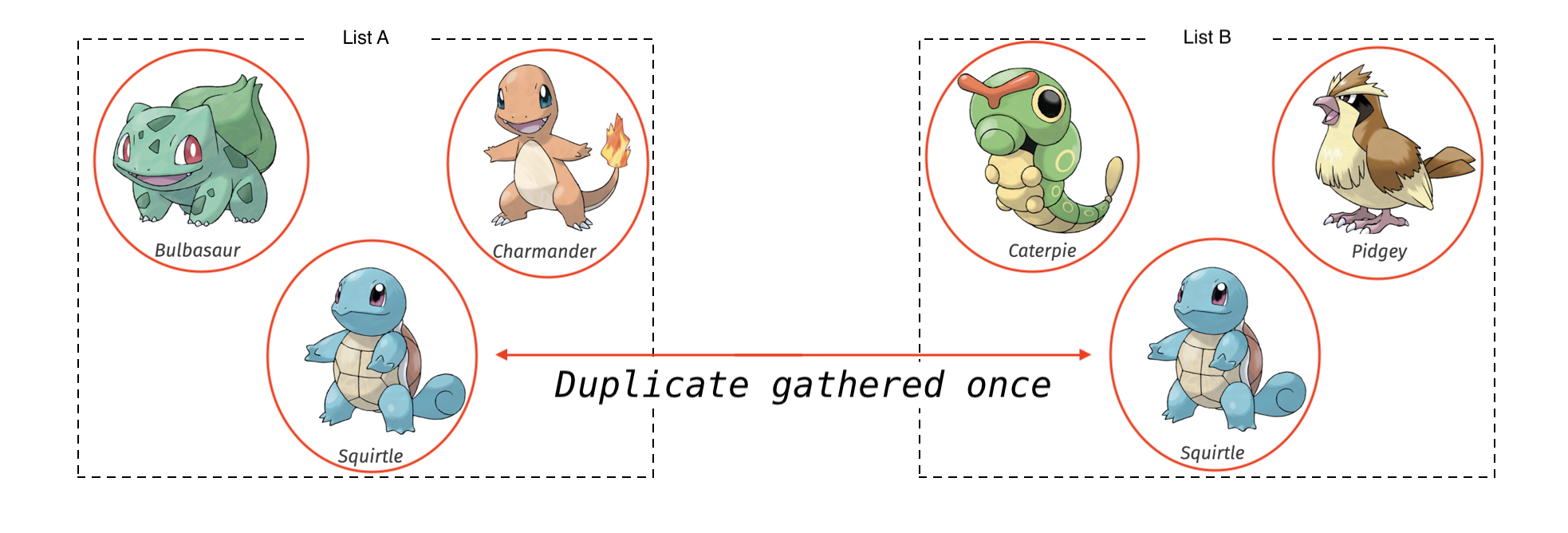Mengenlehre
Effizienten Python-Code schreiben

Logan Thomas
Scientific Software Technical Trainer, Enthought
Mengenlehre
- Ein Bereich der Mathematik, der sich mit Mengen von Objekten beschäftigt.
- insbesondere
sets– Mengen
- insbesondere
- Python hat den Datentyp
set, mit den dazugehörigen Methoden:intersection(): alle Elemente, die in beiden Mengen vorkommendifference(): alle Elemente in einer Menge, aber nicht in der anderensymmetric_difference(): das Gegenteil der Schnittmengeunion(): einzigartige Elemente in beiden Mengen
- Schneller Zugehörigkeitstest
- Prüft, ob ein Wert in einer Sequenz vorkommt oder nicht.
- Nutzung des
inOperators
Objekte mit Schleifen vergleichen
list_a = ['Bulbasaur', 'Charmander', 'Squirtle']
list_b = ['Caterpie', 'Pidgey', 'Squirtle']

Objekte mit Schleifen vergleichen
list_a = ['Bulbasaur', 'Charmander', 'Squirtle']
list_b = ['Caterpie', 'Pidgey', 'Squirtle']

list_a = ['Bulbasaur', 'Charmander', 'Squirtle']
list_b = ['Caterpie', 'Pidgey', 'Squirtle']
in_common = []
for pokemon_a in list_a:
for pokemon_b in list_b:
if pokemon_a == pokemon_b:
in_common.append(pokemon_a)
print(in_common)
['Squirtle']
list_a = ['Bulbasaur', 'Charmander', 'Squirtle']
list_b = ['Caterpie', 'Pidgey', 'Squirtle']
set_a = set(list_a)
print(set_a)
{'Bulbasaur', 'Charmander', 'Squirtle'}
set_b = set(list_b)
print(set_b)
{'Caterpie', 'Pidgey', 'Squirtle'}
set_a.intersection(set_b)
{'Squirtle'}
Effizienzgewinne mit der Mengenlehre
%%timeit
in_common = []
for pokemon_a in list_a:
for pokemon_b in list_b:
if pokemon_a == pokemon_b:
in_common.append(pokemon_a)
601 ns ± 17.1 ns per loop (mean ± std. dev. of 7 runs, 1000000 loops each)
%timeit in_common = set_a.intersection(set_b)
137 ns ± 3.01 ns per loop (mean ± std. dev. of 7 runs, 10000000 loops each)
Set Methode: difference – Unterschied
set_a = {'Bulbasaur', 'Charmander', 'Squirtle'}
set_b = {'Caterpie', 'Pidgey', 'Squirtle'}
set_a.difference(set_b)
{'Bulbasaur', 'Charmander'}

Set Methode: difference – Unterschied
set_a = {'Bulbasaur', 'Charmander', 'Squirtle'}
set_b = {'Caterpie', 'Pidgey', 'Squirtle'}
set_b.difference(set_a)
{'Caterpie', 'Pidgey'}

Set Methode: symmetric difference – symmetrische Differenz
set_a = {'Bulbasaur', 'Charmander', 'Squirtle'}
set_b = {'Caterpie', 'Pidgey', 'Squirtle'}
set_a.symmetric_difference(set_b)
{'Bulbasaur', 'Caterpie', 'Charmander', 'Pidgey'}

Set Methode: union – Vereinigung
set_a = {'Bulbasaur', 'Charmander', 'Squirtle'}
set_b = {'Caterpie', 'Pidgey', 'Squirtle'}
set_a.union(set_b)
{'Bulbasaur', 'Caterpie', 'Charmander', 'Pidgey', 'Squirtle'}

Zugehörigkeitstest mit Sets
# The same 720 total Pokémon in each data structure
names_list = ['Abomasnow', 'Abra', 'Absol', ...]
names_tuple = ('Abomasnow', 'Abra', 'Absol', ...)
names_set = {'Abomasnow', 'Abra', 'Absol', ...}

Zugehörigkeitstest mit Sets
# The same 720 total Pokémon in each data structure
names_list = ['Abomasnow', 'Abra', 'Absol', ...]
names_tuple = ('Abomasnow', 'Abra', 'Absol', ...)
names_set = {'Abomasnow', 'Abra', 'Absol', ...}

names_list = ['Abomasnow', 'Abra', 'Absol', ...]
names_tuple = ('Abomasnow', 'Abra', 'Absol', ...)
names_set = {'Abomasnow', 'Abra', 'Absol', ...}
%timeit 'Zubat' in names_list
7.63 µs ± 211 ns per loop (mean ± std. dev. of 7 runs, 100000 loops each)
%timeit 'Zubat' in names_tuple
7.6 µs ± 394 ns per loop (mean ± std. dev. of 7 runs, 100000 loops each)
%timeit 'Zubat' in names_set
37.5 ns ± 1.37 ns per loop (mean ± std. dev. of 7 runs, 10000000 loops each)
Einzigartige Elemente mit Sets finden
# 720 Pokémon primary types corresponding to each Pokémon
primary_types = ['Grass', 'Psychic', 'Dark', 'Bug', ...]
unique_types = []
for prim_type in primary_types:
if prim_type not in unique_types:
unique_types.append(prim_type)
print(unique_types)
['Grass', 'Psychic', 'Dark', 'Bug', 'Steel', 'Rock', 'Normal',
'Water', 'Dragon', 'Electric', 'Poison', 'Fire', 'Fairy', 'Ice',
'Ground', 'Ghost', 'Fighting', 'Flying']
Einzigartige Elemente mit Sets finden
# 720 Pokémon primary types corresponding to each Pokémon
primary_types = ['Grass', 'Psychic', 'Dark', 'Bug', ...]
unique_types_set = set(primary_types)
print(unique_types_set)
{'Grass', 'Psychic', 'Dark', 'Bug', 'Steel', 'Rock', 'Normal',
'Water', 'Dragon', 'Electric', 'Poison', 'Fire', 'Fairy', 'Ice',
'Ground', 'Ghost', 'Fighting', 'Flying'}
Lass uns die Mengenlehre üben!
Effizienten Python-Code schreiben

